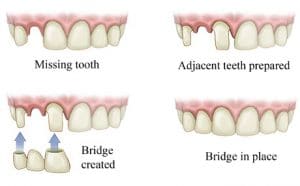Fillings, crowns and bridges – with modern technology these restorative options can be strong and made to look natural. Look no further for superior tooth coloured material to repair and strengthen your teeth.
Restorative Dentistry

Fillings
Composite resin restorations are tooth coloured fillings placed directly into your teeth. You may need a filling if you have a cavity (hole in a tooth) caused by decay or if you have broken your tooth due to some form of trauma. With plenty of shades to choose from, we can match your existing tooth colour quite effectively so the fillings does not appear visible. Composite resin is a mixture of powdered glass and acrylic resin. Unlike the previously used amalgam restorations (metal fillings), composite resin is bonded to the tooth. It mimics the properties of dentine which is the middle layer of the tooth. As such, when placed under pressure it will bend in a similar way to your tooth, resulting in less cracking seen in older materials. Composite resin’s longevity is dependent upon where it is placed in the mouth and the size of the cavity requiring a restoration. On the whole, composite resin restorations are durable and resistant to fracture in small to moderate sized sections.
Crowns & Veneers

These are usually made of ceramic or porcelain and act as a ‘cap’ to completely cover a damaged or compromised tooth. The aim of a dental crown is to reinforce the existing tooth structure and/or change its appearance (shape, colour and position). Crowns are useful when the tooth has had root canal treatment, missing tooth structure is extensive, a crack is suspected in a tooth, to cover a dental implant or to camouflage a badly discoloured or disfigured tooth.
Preparing a tooth for a crown or veneer involves trimming 0.5-1.5mm of enamel. As with any invasive procedure, you must spend time carefully weighing up the pros and cons of going ahead with treatment. This is why at Riverstone Family Dental we complete a full check up prior to going ahead with any fixed prosthodontics treatment.
Bridges

With the advantage of being permanently cemented in your mouth, a bridge can be an effective way to replace a missing tooth. Unlike dentures, bridges are fixed in the mouth and are not removable. In order to get a bridge, it is necessary to have teeth on either side of the gap because essentially, a bridge is two crowns joined together with a false tooth.
The process involved in getting a bridge is preparing the teeth on either side as you would for a crown. This entails removing 1.3-1.5mm of enamel and using these prepared teeth as anchors for the bridge. Bridges are useful when work has been done on the two anchor teeth, for example, they may have fillings (restorations) in them. In this case, a bridge may help increase their structural integrity.
At Riverstone Family Dental, we consider many factors when deciding whether a bridge is suitable for you. These factors include:
- the bone and gum support around the teeth on either side of the gap
- the risk of root canal treatment if the teeth devitalise (if the nerve dies)
- the size of the gap – the longer the span of the bridge, the more it can flex in the middle – therefore increasing the chance of a fracture
- the relationship with the opposing teeth
- any parafunctional habits such as bruxism (teeth grinding) and clenching
The main disadvantage of bridges is that if the bridge fails – for instance, if you develop decay under the bridge or it breaks on a hard piece of food, then you could potentially end up losing the teeth on either side. Although cleaning under the bridge can be cumbersome, it is recommended you do this daily to prevent food trapping leading to a cavity.
Are You A New Patient?
We encourage our new patients to arrive 15 minutes earlier than their scheduled appointment time.
